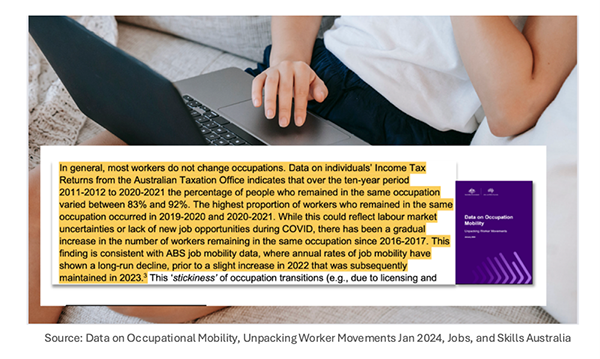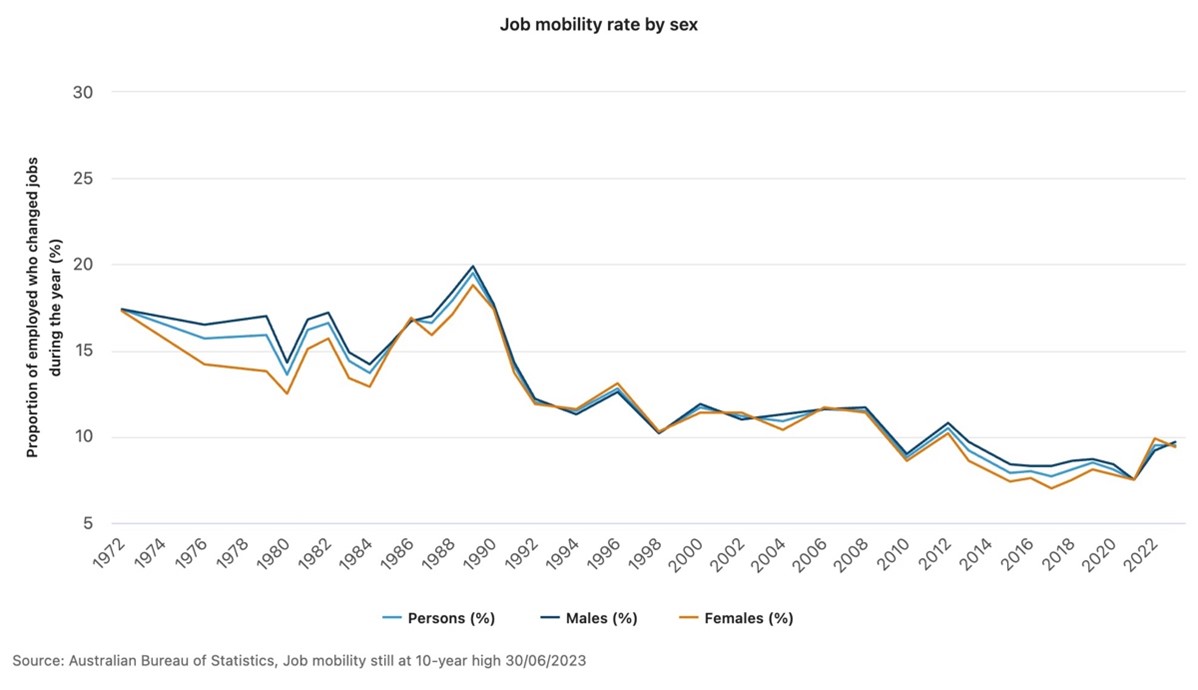Are Careers Getting Stickier? Making Occupational Mobility Easier
19/03/2024
Gillian Kelly is the Director of Outplacement Australia, supporting the staff of workforces across Australia undertaking complex transformation. She is an award-winning, multi-certified resume writer, seasoned professional career development coach, personal branding strategist, and a Fellow Member of CDAA.

I was surprised. Regardless of what I’d heard, not everyone is pivoting. Reading the latest report by Jobs & Skills Australia, it seems safe to say careers remain pretty sticky.
Despite media headlines about record mobility in 2023, people aren’t moving about as much as I thought. And they are certainly not changing paths lightly.
It's interesting reading, honestly. According to the Data on Occupational Mobility, Unpacking Worker Movements Jan 2024 report:
“Data on individuals’ Income Tax Returns from the ATO indicates that over the 10-year period 2011-2012 to 2020-2021 the percentage of people who remained in the same occupation varied between 83% & 92%. The highest proportion of workers who remained in the same occupation occurred in 2019-2020 and 2020-2021. While this could reflect labour market uncertainties or lack of new job opportunities during COVID, there has been a gradual increase in the number of workers remaining in the same occupation since 2016-2017. This finding is consistent with ABS job mobility data, where annual rates of job mobility have shown a long-run decline, prior to a slight increase in 2022 that was subsequently maintained in 2023.”

The report wasn’t what I expected.
I’d heard all the headlines about the great resignation and record mobility since COVID-19. We were all pivoting and hopping jobs—or were we?
According to the data, that didn’t seem to be the case. I sought out Bjorn Jarvis, Head of Labour Statistics with the ABS, for clarification. He confirmed that, yes, we have changed jobs more in the last two years, but that was coming off a low base.
“Job mobility in Australia has generally been trending down for decades and reached a record low of 7.5 percent during the first year of the COVID-19 pandemic. While the 2023 figure might be higher and is, in fact, the highest it’s been since the early 2010s, it’s still relatively low compared to earlier decades.”

It’s not just job mobility; it's occupational mobility too.
What was most interesting to me from the mobility report and my conversation with Bjorn Jarvis was that while general mobility has been in decline over time, it is also being seen across occupational mobility.
Although we might have changed employers more often recently, most of us still usually stay put in our occupational fields. True, there are some occupations where shifts in and out are more frequent, but for the most part, people remain in their occupational lanes.
Thinking about my own clients, this makes sense. People don’t change careers lightly. Even after redundancy. How can they, when faced with the brutal reality that hirers typically prefer candidates with direct job and industry experience?
Add to this expensive retraining, particularly in regulated industries, a gruelling job search and the likelihood of a pay cut commensurate with their new levels of expertise, and leaping isn’t something to be trivialised.
How do we make mobility easier?
This data raised some big questions for me. We are in a time when in-demand skills are transforming fast. With technology-driven shifts and other factors impacting the world of work, change is afoot. Some jobs may grow, others may shrink, and most will alter. The fallout is there will be people looking down the barrel of needing to transition to new paths, and a lot of organisations will need faster skills mobility.
So, if people and organisations need to shift, how do we help people embrace mobility and move more freely? How do we make this journey more manageable?
Work with organisations to remove mobility barriers.
It seems to me a big piece of work needs to happen inside organisations. I love watching new skills-based organisational approaches like talent marketplaces. The more career practitioners can help facilitate skills and career mobility inside organisations, the better for all parties. Reinventing yourself is still not easy but shifts inside the business take away some risk.
This means:
- Encouraging people to look inside the walls of their current business when considering a career change.
- Helping people take an agile view to learning, with a lens focused on opportunities beyond their current occupation, job title and work type.
- Improving conversations between talent and leaders so job titles become less relevant and skills and potential more centre-stage.
- Creating cultures where progression isn’t only defined as up.
Work with potential career changers to address issues of self-doubt, identity and agency.
The second piece is our work with our clients. Change isn’t easy. If it were, everyone would be doing it. As most career coaches have experienced, when it comes to addressing mobility inertia, it's not just financial pressures and skills gaps causing career change reluctance. Beyond the question of ‘can I afford to do it?’, are the ever-present psychological challenges of self-doubt, identity, and agency.
Common questions I hear people ask themselves:
- Is this the right move? Is this the right time?
- Will employers take a chance on me?
- What will other people think of this decision?
- Will I regret it later?
It takes time and safety to explore these issues as they emerge.
Next comes the question of agency. Most people don’t know where to start with a career change. We are notoriously bad at identifying our own transferable skills. Even when we have identified them, we struggle to connect these dots to create new pictures of our future.
People need support to recreate their professional identity. The sooner we can move people away from describing their brand in terms of job titles, the easier this will be. We need to help people to rewrite their story as they go, and to continually and confidently take the necessary steps forward to evolve their careers in our new shifting work landscape.